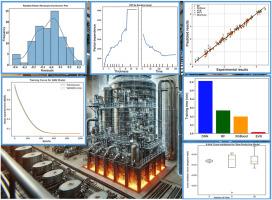利用机器学习预测工业系统积灰:提高维护和运行效率
IF 4.3
2区 材料科学
Q2 ENGINEERING, CHEMICAL
引用次数: 0
摘要
预测工业环境中的积灰对于提高运营效率、实现主动维护、减少停机时间和优化工厂性能至关重要。了解这些过程需要分析关键参数,包括时间,热流密度,粒度,速度,过剩空气比,炉温,热负荷和氧化物浓度,特别关注沉积厚度。传统的方法往往无法捕捉到这些相互作用的复杂性,因此需要创新的方法来进行准确的预测和分析。实验数据与支持向量回归(SVR)、随机森林(RF)、深度神经网络(DNN)和极端梯度增强(XGBoost)四种算法一起,对20个特征进行了分析,并对其预测能力进行了稳健评估。此外,SHAP (SHapley加性解释)值的使用为研究引入了一个新的维度,使理解每个特征对模型预测的贡献具有可解释性和透明度。结果表明,RF和XGBoost模型的预测精度非常高,R2值为0.99,平均绝对误差(MAE)最小。一种新颖的训练时间比较表明,SVR由于结构简单,在速度上优于其他算法,使其在实时应用中非常高效。相关分析表明,在不同表面温度下,沉积厚度与关键参数(如时间、热流密度和沉积概率)之间存在密切关系。时间直接影响沉积厚度,因为颗粒在长时间的操作中积累和烧结。热流通过热泳运动驱动粒子运动,影响表面粘附并增加沉积概率。表面温度调节颗粒的粘附性和炉渣粘度,最佳温度可使粘性和沉积概率最大化。本文章由计算机程序翻译,如有差异,请以英文原文为准。

Predicting ash accumulation in industrial systems using machine learning: Enhancing maintenance and operational efficiency
Predicting ash accumulation in industrial environments is crucial for improving operational efficiency, enabling proactive maintenance, reducing downtime, and optimizing plant performance. Understanding of these processes requires the analysis of key parameters, including time, heat flux, particle size, velocity, excess air ratio, furnace temperature, heat load, and oxide concentrations, with a particular focus on deposition thickness. Traditional methods often fail to capture the complexity of these interactions, necessitating innovative approaches for accurate prediction and analysis. The experimental data, along with four algorithms, i.e. Support Vector Regression (SVR), Random Forest (RF), Deep Neural Network (DNN), and Extreme Gradient Boosting (XGBoost), were employed to analyze 20 features, providing a robust evaluation of their predictive capabilities. Furthermore, the use of SHAP (SHapley Additive Explanations) values introduces a novel dimension to the study, enabling interpretability and transparency in understanding the contribution of each feature to the model's predictions. The results demonstrate exceptional predictive accuracy for the RF and XGBoost models, achieving an R2 value of 0.99 and minimal mean absolute errors (MAE). A novel comparison of training times reveals that SVR outperforms the other algorithms in speed due to its simpler structure, making it highly efficient for real-time applications. Correlation analysis identifies strong relationships between deposition thickness and key parameters such as time, heat flux, and deposition probability at varying surface temperatures. Time directly influences deposition thickness, as particles accumulate and sinter over prolonged operation. Heat flux drives particle movement through thermophoresis, affecting surface adhesion and increasing deposition probability. Surface temperature modulates particle adhesion and slag viscosity, with optimal temperatures maximizing stickiness and deposition probability.
求助全文
通过发布文献求助,成功后即可免费获取论文全文。
去求助
来源期刊

Particuology
工程技术-材料科学:综合
CiteScore
6.70
自引率
2.90%
发文量
1730
审稿时长
32 days
期刊介绍:
The word ‘particuology’ was coined to parallel the discipline for the science and technology of particles.
Particuology is an interdisciplinary journal that publishes frontier research articles and critical reviews on the discovery, formulation and engineering of particulate materials, processes and systems. It especially welcomes contributions utilising advanced theoretical, modelling and measurement methods to enable the discovery and creation of new particulate materials, and the manufacturing of functional particulate-based products, such as sensors.
Papers are handled by Thematic Editors who oversee contributions from specific subject fields. These fields are classified into: Particle Synthesis and Modification; Particle Characterization and Measurement; Granular Systems and Bulk Solids Technology; Fluidization and Particle-Fluid Systems; Aerosols; and Applications of Particle Technology.
Key topics concerning the creation and processing of particulates include:
-Modelling and simulation of particle formation, collective behaviour of particles and systems for particle production over a broad spectrum of length scales
-Mining of experimental data for particle synthesis and surface properties to facilitate the creation of new materials and processes
-Particle design and preparation including controlled response and sensing functionalities in formation, delivery systems and biological systems, etc.
-Experimental and computational methods for visualization and analysis of particulate system.
These topics are broadly relevant to the production of materials, pharmaceuticals and food, and to the conversion of energy resources to fuels and protection of the environment.
 求助内容:
求助内容: 应助结果提醒方式:
应助结果提醒方式:


